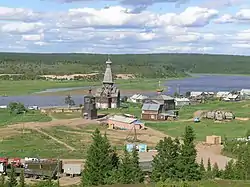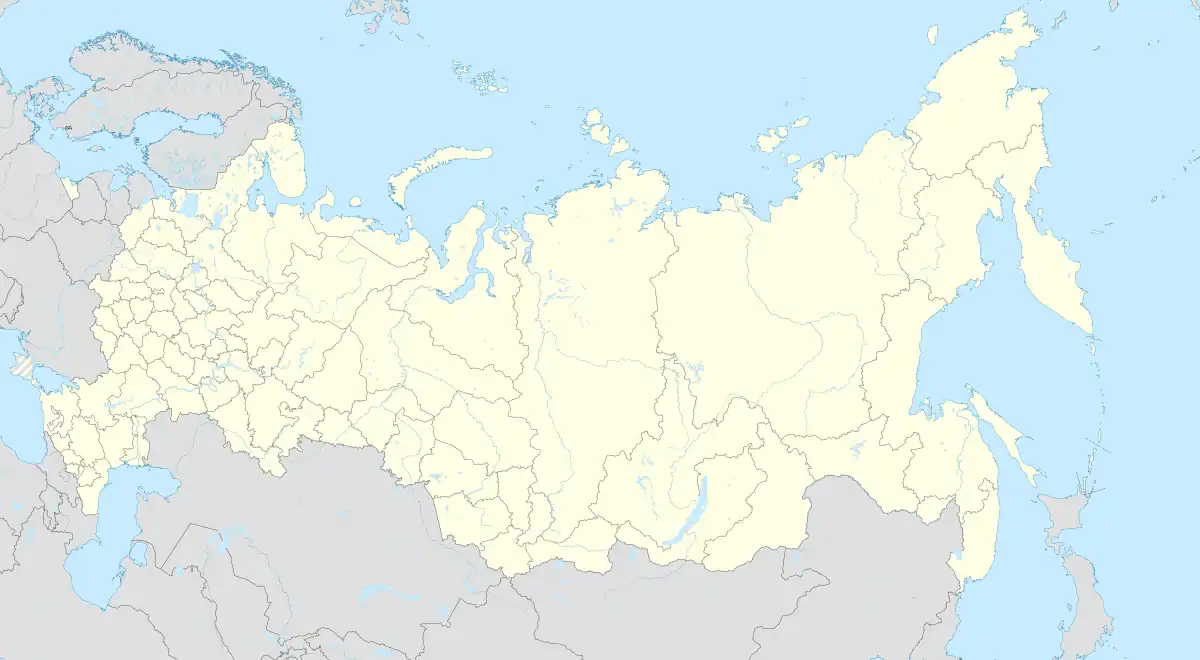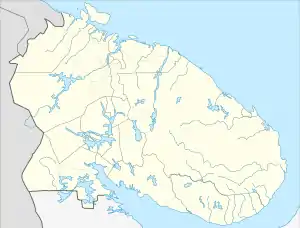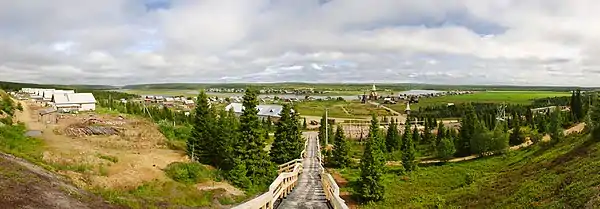Varzuga (rural locality)
Varzuga (Russian: Варзуга) is the rural locality (a selo) in Tersky District of Murmansk Oblast, Russia,[1] located on the Varzuga River. Municipally, it is a part and the administrative center of Varzuga Rural Settlement of Tersky Municipal District.[4] Population: 363 (2010 Census).[3]
Varzuga
Варзуга | |
|---|---|
 View of Varzuga | |
_proposal_(2006).jpg.webp) Coat of arms | |
Location of Varzuga | |
 Varzuga Location of Varzuga  Varzuga Varzuga (Murmansk Oblast) | |
| Coordinates: 66°23′57″N 36°35′32″E | |
| Country | Russia |
| Federal subject | Murmansk Oblast[1] |
| Administrative district | Tersky District[1] |
| First mentioned | 1466[2] |
| Elevation | 52 m (171 ft) |
| Population | |
| • Total | 363 |
| • Municipal district | Tersky Municipal District[4] |
| • Rural settlement | Varzuga Rural Settlement[4] |
| • Capital of | Varzuga Rural Settlement[4] |
| Time zone | UTC+3 (MSK |
| Postal code(s)[6] | 184712 |
| OKTMO ID | 47620401101 |
History
First mentioned in 1466, Varzuga, along with Umba, is the first documented permanent Russian settlement on the Kola Peninsula,[2] although it is likely that it had been established as early as the second quarter of the 15th century.[7] The 1466 document describes a transaction between Timofey Yermolinich, a resident of Varzuga, and the Solovetsky Monastery, to which he transferred his lands along the Varzuga River and the hunting grounds along the sea coast.[7] Other documents of the 1460s indicate that the residents of Varzuga were the second generation of the original Russian settlers.[7] The documents refer to the residents' land plots as otchinas, meaning that they were inherited from the fathers, but there is no mention of dedinas (lands inherited from the grandfathers).[7]
From the second half of the 15th century, it served as the seat of Varzuzhskaya Volost (which was abolished in 1841).
By 1563, Varzuga's population grew to 124 homesteads, who were primarily salmon fishers.[8] In the mid-17th century, some of the residents moved out to the coast, where they founded new villages, such as Kuzomen and Tetrino.[8]
In 1861, Varzuga was a part of Kemsky Uyezd of Arkhangelsk Governorate.[9] It had three Orthodox churches and housed its own rural government.[9] The population was 249 (120 male and 129 female); living in 54 homesteads.[9] The 1897 Census counted 793 residents, and the population grew further. By 1910, there were 1,001 people living in 161 homesteads.[8] Educational facilities at the time included a government college and a parochial school.[8]

Culture
An 1850 Pomor izba located in the village was formerly considered to be a heritage site of federal importance, but was excluded from the list in 1997.[10]
References
- Государственный комитет Российской Федерации по статистике. Комитет Российской Федерации по стандартизации, метрологии и сертификации. №ОК 019-95 1 января 1997 г. «Общероссийский классификатор объектов административно-территориального деления. Код 47 220 000 004», в ред. изменения №278/2015 от 1 января 2016 г.. (State Statistics Committee of the Russian Federation. Committee of the Russian Federation on Standardization, Metrology, and Certification. #OK 019-95 January 1, 1997 Russian Classification of Objects of Administrative Division (OKATO). Code 47 220 000 004, as amended by the Amendment #278/2015 of January 1, 2016. ).
- Administrative-Territorial Divisions of Murmansk Oblast, p. 18
- Федеральная служба государственной статистики. Территориальный орган федеральной службы государственной статистики по Мурманской области (Мурманскстат) (Federal State Statistics Service. Territorial Branch of the Federal Statistics Service in Murmansk Oblast (Murmanskstat)) (2012). "2010. Статистический сборник "Численность, размещение и возрастно-половой состав населения Мурманской области. Итоги Всероссийской переписи населения". Том 1" [2010 Statistical Digest "Size, Distribution, and the Age and Gender Characteristics of the Population of Murmansk Oblast. Results of the All-Russian Population Census] (in Russian). Federal State Statistics Service. Archived from the original on December 22, 2012. Retrieved September 10, 2012.
- Law #545-01-ZMO
- "Об исчислении времени". Официальный интернет-портал правовой информации (in Russian). June 3, 2011. Retrieved January 19, 2019.
- Russian Post. Varzuga (in Russian)
- Газета "Мурманский Вестник". Иван Ушаков. Варзуга
- Газета "Терский Берег", №37, 14 сентября 2002 г. "Селения Терского берега"
- Центральный статистический комитетъ Министерства внутреннихъ делъ (1861). Списки населённыхъ мѣстъ Россійской Имперіи. Санктпетербургъ. p. 23.
{{cite book}}: CS1 maint: location missing publisher (link) - Decree #452, Appendix 2
Sources
- Архивный отдел Администрации Мурманской области. Государственный Архив Мурманской области. (1995). Административно-территориальное деление Мурманской области (1920–1993 гг.). Справочник. Мурманск: Мурманское издательско-полиграфическое предприятие "Север".
- Мурманская областная Дума. Закон №545-01-ЗМО от 8 декабря 2004 г. «О статусе, наименованиях и составе территорий муниципального образования Терский район и муниципальных образований, входящих в его состав». Вступил в силу 1 января 2005 г. Опубликован: "Мурманский Вестник", №238, стр. 3, 15 декабря 2004 г. (Murmansk Oblast Duma. Law #545-01-ZMO of December 8, 2004 On the Status, Names, and Composition of the Territories of the Municipal Formation of Tersky District and of the Municipal Formations It Comprises. Effective as of January 1, 2005.).
- Президент Российской Федерации. Указ №452 от 5 мая 1997 г. «Об уточнении состава объектов исторического и культурного наследия федерального (общероссийского) значения». Вступил в силу по истечении 7 дней после дня официального опубликования. Опубликован: "Российская газета", №93-94, 15 мая 1997 г. (President of the Russian Federation. Decree #452 of May 5, 1997 On the Updating of the List of Objects of Historical and Cultural Heritage of the Federal (All-Russian) Importance. Effective as of after 7 days after the official publication date.).
External links
- Official website of the Government of Murmansk Oblast. Varzuga Rural Settlement, map and information (in Russian)
- Information about Varzuga (in Russian)
- Varzuga: Outpost on the White Sea